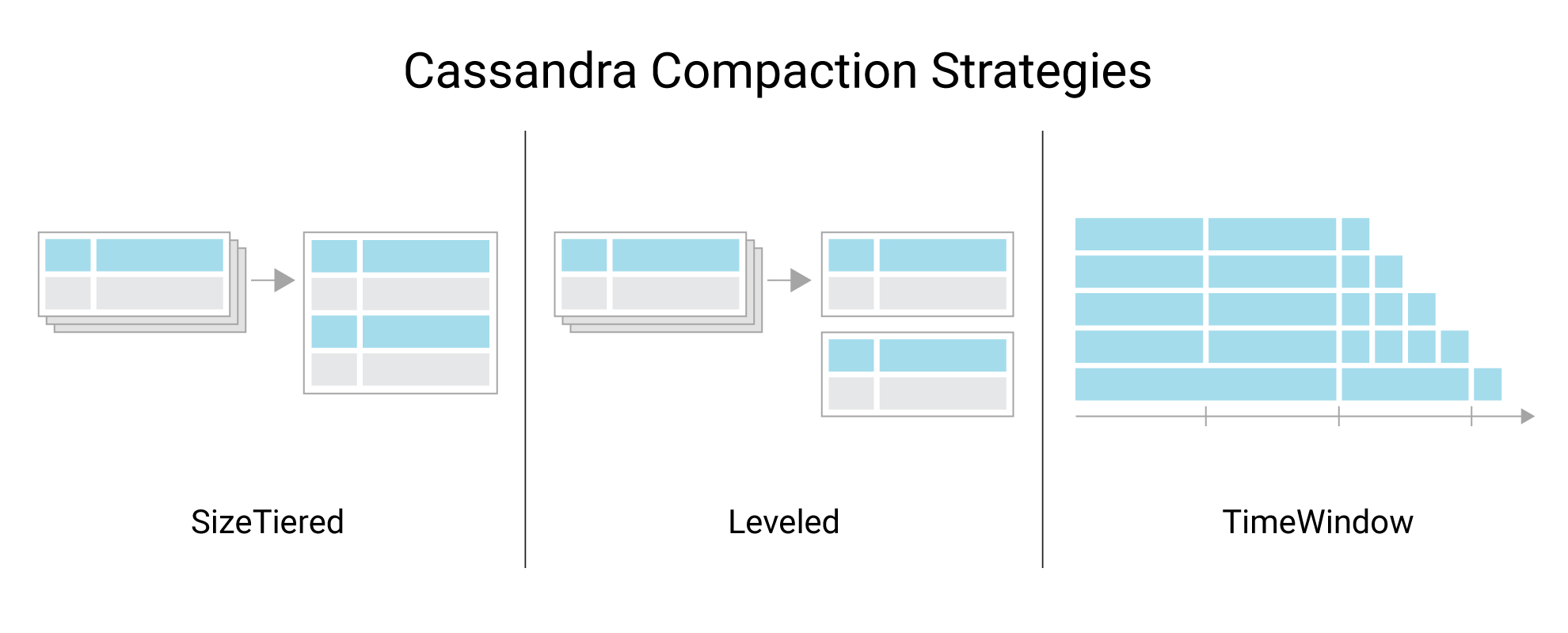Cassandra Compaction Strategy FAQs
Why Is Compaction Important in Cassandra?
Compaction is a critical process in Apache Cassandra that helps maintain the performance and efficiency of the database over time. As Cassandra writes data, it doesn’t overwrite existing values directly.
Instead, it appends new data to disk in the form of immutable files called SSTables. Without compaction, these SSTables would accumulate endlessly, leading to slower read operations, increased disk usage, and the persistence of outdated or deleted data.
Compaction works by merging multiple SSTables into a smaller number of files, eliminating duplicate rows, purging tombstones (markers for deleted data), and reorganizing records to optimize data locality. This improves read latency by reducing the number of files that need to be scanned and also frees up storage space and keeps write amplification under control.
Types of Cassandra Compaction Strategies
Cassandra offers several compaction strategies, each designed to optimize performance based on different data models and access patterns. Choosing the right strategy is critical for maintaining efficiency in read and write operations, especially as your dataset grows.
- SizeTieredCompactionStrategy (STCS): This is the default strategy and works best for write-heavy workloads. It groups SSTables of similar sizes and merges them when enough files accumulate. While efficient for writes, STCS can lead to high read amplification over time.
- LeveledCompactionStrategy (LCS): Ideal for read-heavy workloads, LCS organizes SSTables into levels with fixed sizes. Each level contains non-overlapping data, making reads faster by reducing the number of SSTables scanned. However, it requires more disk I/O and can be more expensive in terms of write amplification.
- TimeWindowCompactionStrategy (TWCS): Best suited for time-series data, TWCS compacts SSTables based on time windows (e.g., hourly or daily). This strategy helps ensure that older data remains untouched while newer data is actively compacted, improving performance and reducing unnecessary disk usage.
- UnifiedCompactionStrategy (UCS): A general‑purpose compaction strategy introduced in Cassandra 5. It can be tuned to behave more like leveled or size‑tiered compaction (and, with careful parameters, to handle time‑series workloads). Its behavior can be changed at runtime by adjusting the scaling parameter. UCS also parallelizes compaction via sharding to improve throughput on high‑density nodes.
The best option in a given situation depends on your specific workload, query patterns, and retention policies. Cassandra also allows you to change compaction strategies per table, giving you flexibility to fine-tune performance across your data model.
Challenges of Compaction Strategy in Cassandra
While compaction is essential for maintaining Cassandra’s performance, it comes with several operational challenges that can lead to performance bottlenecks and resource exhaustion..
One of the primary issues is resource contention. Compaction is a disk- and CPU-intensive process that runs in the background but can compete with live read and write operations, especially under heavy workloads. If not properly tuned, compaction can lead to increased latency or even node instability.
Another challenge lies in selecting the appropriate compaction strategy. Each strategy has trade-offs in terms of read/write performance, disk space usage, and compaction frequency. Using the wrong strategy for your workload can result in excessive SSTables, high read amplification, or inefficient disk utilization.
Additionally, tombstone handling (deletes) can become problematic. If compaction doesn’t run frequently enough, deleted data (represented by tombstones) may persist for longer than intended, increasing storage overhead and degrading query performance.
Cassandra Compaction Strategy Best Practices
Choose the Right Strategy for Each Table
- STCS: Best for high-throughput, write-heavy workloads.
- LCS: Ideal for read-heavy workloads with low-latency requirements.
- TWCS: Recommended for time-series data with predictable time-based writes.
- UCS: (Cassandra 5+) Best for mixed workloads or when you’re unsure which strategy to use; can be tuned at runtime.
Monitor Compaction Health
- Use tools like nodetool compactionstats and nodetool cfstats to track compaction activity, SSTable counts, and pending tasks.
- Watch for compaction lag, which can lead to increased read latency and storage bloat.
Tune Key Compaction Settings
- Adjust compaction_throughput_mb_per_sec to control the impact of compaction on system resources.
- Review tombstone_threshold and GC grace settings to ensure timely removal of deleted data.
Minimize Resource Contention
- Schedule major compactions during off-peak hours when possible.
- Avoid overlapping compactions on the same table to reduce I/O strain.
Test Before Production Changes
- Always validate compaction strategy or configuration changes in a staging environment.
- Analyze disk I/O and query performance before and after changes to catch regressions early.
Does ScyllaDB Support Compaction Strategies Like Cassandra?
Yes. ScyllaDB supports compaction strategies similar to those in Apache Cassandra, including SizeTieredCompactionStrategy (STCS), LeveledCompactionStrategy (LCS), and TimeWindowCompactionStrategy (TWCS). These strategies function similarly, helping manage SSTables and optimize storage and performance.
ScyllaDB also offers an additional compaction strategy that is not available in Cassandra: incremental compaction strategy (ICS). This compaction strategy enhances Cassandra’s existing Size-tiered Compaction Strategy (STCS) strategy by dividing SStables into increments. ICS significantly reduces the temporary space amplification which is typical of STCS. That reduction makes more disk space available for storing user data, allowing users to go beyond the typical requirement of 50% free space.
Users migrating from Cassandra to ScyllaDB can continue to use familiar compaction strategies while benefiting from improved throughput and reduced compaction overhead.
